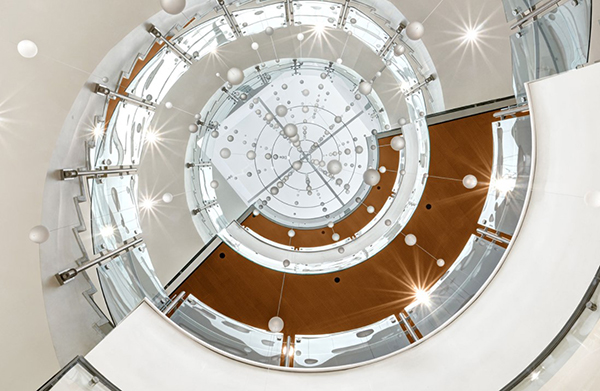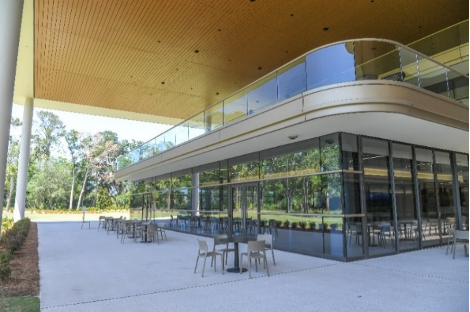There’s no denying that daylighting continues to emerge as a key design element for commercial buildings.

By: Laura Rygielski Preston, President of Trex Commercial Products
There’s no denying that daylighting – the harvesting and distribution of natural light – continues to emerge as a key design element for commercial buildings. As an increasing number of businesses recognize the many health, energy and environmental benefits that daylighting offers, designers and engineers are looking for new ways to let the light in.
Research clearly supports this trend with daylighting directly linked to improved mood, enhanced morale, less fatigue and reduced eyestrain* – factors that can and will lead to increased job satisfaction and productivity. Equally important are the cost savings daylighting offers; according to a report by the U.S. Department of Energy, total energy costs can be reduced by as much as 1/3 through the strategic use of daylighting technologies in some commercial buildings.**
And finally, reducing the use of electrical energy also reduces the amount of greenhouse gases released into the environment. In fact, daylighting has become so important to the building industry in regard to the environment that it is considered a critical performance measure in green building certification programs such as LEED.
While windows and skylights remain the first and most obvious daylighting choices for commercial buildings, other architectural elements can enhance the impact of daylighting and contribute considerable benefits. One such option is glass railing. When used on stairways, overlooks and walkways, glass railing can play a key role in facilitating light infiltration. As part of an overall integrated design, or a retrofit, glass railing can go a long way toward opening up a space and enhancing the ambiance and safety of any environment from healthcare and educational settings to sports complexes and office spaces.
The David A. Tepper Quadrangle at Carnegie Mellon University is a great example of a building intentionally designed to harness the power of daylighting. The campus’ largest building reflects a new model of higher education that connects teaching, learning and innovation. Open from floor to ceiling, the design of the space was created to offer an environment for collaboration and interconnection. It’s modern design, enhanced throughout by Trex Commercial Products’ Track Rail™ frameless glass railing system and topped off by a glass roof, emphasizes open space with an abundance of natural light for improving the well-being of the students and faculty while decreasing stress levels.

Earlier this year, we completed work on the new PGA Tour Global Home in Ponte Vedra Beach, Fla. Surrounded by a freshwater lake and acres of lush wetlands, the 187,000 sq. ft. facility features a distinctive indoor-outdoor concept that emphasizes the environment while encouraging natural light to permeate the building, especially in the 44-foot-tall Grand Atrium. Enhancing sightlines and safety throughout the state-of-the-art facility are more than 2,500 linear feet of clear glass Track Rail featured in the atrium and across the exterior balconies to optimize views and enhance employee wellness.

There are a number of factors to keep in mind when looking to leverage glass railings as part of a building’s daylighting system. As a leading provider of architectural railings, Trex Commercial Products has more than three decades of experience manufacturing glass railings and working with glaziers, as well as architects, general contractors and installers. Following are five key considerations we prioritize with our customers:
Our team utilized 3-D laser scanning technology to create a signature, multi-level curved glass staircase for the lobby of Colorado State University Health and Medical Center in Ft. Collins. When the original railing supplier was unable to complete the work just as the project was 90% complete, we were able to step in and quickly produce the remaining scope, integrating it seamlessly with the existing work thanks to our high-definition surveying capabilities. The process used a 3-D scanning tool to produce high accuracy mapping of the project’s design and dimensions that eliminated the need for field dimensioning and fabrication rework.

At Trex Commercial Products, we offer design-to-delivery support with a focus on simplifying glass railing projects and providing a stress-free experience for architects and glaziers. In addition to using the most advanced 3-D modeling, our seasoned team reviews each specification to ensure structural integrity and IBC code compliance. Leveraging our experience, we collaborate with construction teams to create synergy with the project’s design intent and the constructability of the final product.
Features such as all-glass facades, exterior glass windscreens and glass architectural railings have been shown to provide a wide range of benefits from reducing depression to increasing quality of sleep and decreasing the length of a hospital stay. The many benefits glass has to offer makes it an excellent investment that is bound to pay off in both health and cost savings for years to come. For more information about the role that glass railings can play in enhancing daylighting, visit www.trexcommercial.com.
Sources
*National Renewable Energy Laboratory
About the Author
Laura Rygielski Preston is president of Trex Commercial Products, a national leader in architectural railings for commercial applications. Since 1990, the company has been committed to elevating the abilities of all people to safely access and enjoy amazing life experiences, while building an industry-leading reputation for quality and customer service. Based in Minneapolis, Trex Commercial Products, Inc. is a subsidiary of Trex Company, Inc. To learn more, visit www.trexcommercial.com.
In this episode, I sat down with Beejan Giga, Director | Partner and Caleb Emerson, Senior Results Manager at Carpedia International. We discussed the insights behind their recent Industry Today article, “Thinking Three Moves Ahead” and together we explored how manufacturers can plan more strategically, align with their suppliers, and build the operational discipline needed to support intentional, sustainable growth. It was a conversation packed with practical perspectives on navigating a fast-changing industry landscape.